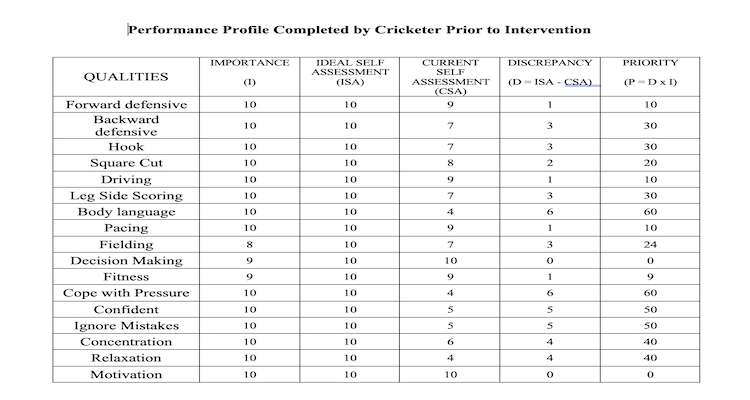
Performance profiling (Butler, 1989, Butler & Hardy, 1992) enables a performer to identify areas in their game that can be improved. These may be either physical skills or mental skills.
Performance profiling can be a useful tool for athletes who want to improve their performance in their respective sports. By using performance profiling, athletes can gain a better understanding of what areas they need to improve on.
Performance profiling is typically used by sport psychologists when working with an athletes but it can also be used by other sports professionals such as coaches, or fitness trainers. The image shows a complete performance profile of a cricket batsmen who was working with a sport psychologist.
First the batsman identified those qualities he needed to succeed. He then identified the importance of these qualities for success. Then he ranked where he felt he currently was on each of those qualities. Areas to improve or develop with the greatest discrepancy score were then identified. The discrepancy score was a combination of the importance of the attribute and difference between the ideal self-rating and current self-rating. The completed performance profile is shown in in the image and he identified that from a psychological perspective the attributes that he needed to improve on were:
Firstly, athletes can use performance profiling to identify their strengths and weaknesses. By understanding which mental skills they excel at and which ones they struggle with, athletes can work to improve their weaker areas and build on their strengths.
Secondly, performance profiling can help athletes set goals for themselves. By identifying their weaknesses, athletes can set goals that target those areas and work towards improving them. For example, if an athlete struggles with anxiety control, they can set a goal to practice relaxation techniques before competitions.
Thirdly, athletes can use performance profiling to monitor their progress over time. By taking the performance profile at different points throughout their training, athletes can track their improvement and see the impact of their efforts. This can provide motivation and encourage athletes to continue working on their mental skills.
Lastly, athletes can use performance profiling to work with coaches and trainers to develop a training program that addresses their specific needs. Coaches and trainers can use the results of the performance profile to design targeted interventions and provide support to athletes as they work on improving their mental skills.
In conclusion, performance profiling can be a valuable tool for athletes who want to improve their performance. By identifying strengths and weaknesses, setting goals, monitoring progress, and working with coaches and trainers, athletes can use performance profiling to develop a comprehensive plan for improving their mental skills and achieving their goals.
Based what areas have been identified in the Performance profile setting effective goals to work on psychological skills can be a helpful way to improve an athlete's mental performance. Here are some tips for setting effective goals:
By setting effective goals that are specific, measurable, challenging but achievable, relevant, and incorporating feedback, athletes can work on improving their psychological skills and ultimately enhance their overall athletic performance.
Overall, performance profiling can be an effective tool for improving athletic performance. By identifying an athlete's strengths and weaknesses and providing targeted interventions and training, performance profiling can help athletes develop the mental skills they need to perform at their best.
References
Butler, R. J. (1989). Psychological preparation of Olympic boxers. In J. Kremer and W. Crawford (Eds.), The psychology of sport: Theory and practice. (pp. 74-84). Leicester. BPS.
Butler, R.J. & Hardy, L. (1992) The Performance Profile: Theory and Application. The Sport Psychologist, 6, 253-264.
